NAZARI, Giovanni Battista.
Della tramutatione metallica sogni tre […] aggiuntovi di nuovo la Concordanza dei Filosofi
Brescia, Pietro Maria Marchetti, 1599£8,750.00
FIRST EDITION of second work. 4to, (xvi) 231 (i). Roman and italic letter, woodcut floriated and historiated initials, headpieces and typographic ornaments. Aldine device to t-p and verso of last, 17 half to full-page woodcuts (some repeated) depicting the author, grotesque dragons and snakes with multiple heads, a donkey, Mercury, inscribed plinths, one table with letters in different alphabets. T-p a bit dusty, occasional fingermarks to margins, light age yellowing to a couple of central ll., small ink stain to upper margin of one fol. A good copy, crisp and clean, in contemporary vellum, covers triple gilt ruled with flower tools at corners and floral centrepiece, spine gilt ruled in compartments with square-shaped ornaments gilt at centres, all edges gilt and gauffered. Small label ‘696’ to front pastedown.
A good copy of this fascinating alchemic treatise on the transmutation of metals, beautifully illustrated and in a contemporary binding. This is the third edition, the first to include the ‘Concordanza dei Filosofi’ at the end, here published for the first time.
Giovanni Battista Nazari (XVI century) was an Italian humanist, historian and alchemist of Saiano, a small town in the province of Brescia (Lombardy, Italy). A scholar of the history and traditions of Brescia, he is most known for his philosophical-alchemical studies. “Du Fresnoy [French bibliographer, 1674-1755] says Nazari had read an infinity of authors, even those little known, and had worked on the subject [i.e. alchemy] for forty years” (Ferguson).
‘Three dreams on the transmutation of metals’, recounts three allegorical journeys, presented in the form of dreams, to the kingdoms of alchemy. The author is guided by Nymphs firstly to the sophist kingdom, based on false alchemical principles, then to the real kingdom, functioning in nature, and finally to the philosophical kingdom, which produces the true metamorphosis of the human into the divine. “The primary model for this work is an alchemical reinterpretation of the Hypnerotomachia Poliphili (1499). The pilgrim-hero of Nazari’s story passes through forests, villages, lakes, tombs, gardens, labyrinths, arches, pyramids, places generally characterized by elaborate architectural constructions and decorated with statues and enigmatic inscriptions. He stops to look at ‘odd inventions’ and then ‘considers them and goes over them in his memory’. The reader is invited, even required, to do the same, as she/he turns the pages of the book and finds bizarre, hideous, and startling illustrations, such as a dragon with three heads, or an emasculated Mercury with no hands or feet, or a donkey playing a pipe surrounded by dancing monkeys” (Bolzoni). The author is represented sleeping in an oak-wood, or listening to the teachings of Count Bernardus Trevisanus, an Italian alchemist whose name is probably a pseudonym, and details of his life appear to be fictitious. Another curious woodcut depicts a table with 45 compartments, each containing the first letter of the alphabets of different languages.
Appended at the end, we find ‘Concordanza dei Filosofi’, which the author presents as “extracts from the books of the philosophers, divided into theory and practice”. It contains a series of sections summarising and translating works ascribed to the alchemist Arnaldus de Villa Nova, mainly concerning the philosophers’ stone. These chapters are titled: ‘Rosario de Filosofi’, ‘Novo Lume’ and ‘Libro chiamato Magisterio’. Remarkably, this edition also includes a famous poem by Rigino Danielli on the philosopher’s stone: particularly appreciated by the Italian alchemists of the XV and XVI centuries, this poem is known in different versions and imitations.
USTC 844354; BM STC It. 16th century, p. 463; Graesse IV, p. 652; Duveen p. 426; Wellcome I, 4517; Caillet 7937; Ferguson II, 131; Bibliotheca Esoterica 3232. Not in Brunet. L. Bolzoni, The Gallery of Memory (1995)In stock










